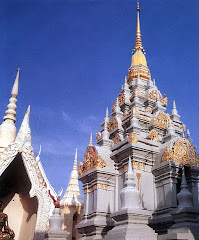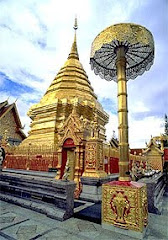
[Photo credits to www.tat.or.th]Structures built during the reign of King Narai the Great include:
Chantara Phaisan Pavilion
The first Palace of King Narai the Great in Lop Buri, the Pavilion was subsequently turned into an audience hall after he moved his residence to the Suttha Sawan Pavilion. The fact that the building is of pure Thai architectural style indicates that no French architects were involved in the design and construction process. King Rama IV (King Mongkut of the Ratanakosin era) restored the building in 1863. The Pavilion was once used by the privy-council as a meeting hall. Now, it serves as a hall displaying archaeological and art objects, especially the Lop Buri-style stone Buddha images, historic paintings from the era of King Narai the Great and Buddhist art objects from the Ayutthaya and Ratanakosin period.
Phra Khlang Supharat
This compound was built as a place to store royal treasures and royal goods sold to foreign merchants during the late 1600s. It is commonly known as the Twelve Treasure Houses.
Elephant and Horse Stables
This compound is located close to the wall separating the outer and middle sections of the Palace.
The Water Reservoir
Constructed during the reign of King Narai the Great, the reservoir stored water which came from a freshwater lake Tale Chupsorn, through the well designed terra cotta pipes. Tale Chupsorn was the main lake supplying drinking water to Lop Buri residents.
The Dusit Sawan Thanya Maha Prasat Hall
Constructed under the royal command of King Narai the Great, the Hall was formerly used by King Narai as an audience hall receiving high-ranking foreign ambassadors. This was the place where the King received Chevalier de Chaumont, the representative of King Louis XIV of France. The Hall was built in a perfect blending of French and Thai architectural styles.
The Suttha Sawan Pavilion
The Pavilion was once located amidst a beautifully decorated garden with ponds and fountains. This was the place where King Narai the Great resided and died on 11 July 1688. Apart from the Pavilion, which had been restored by King Mongkut, only the remains of man-made hills and fountains can be seen.
Kraison Siharat Hall
Commonly known as Phra Thinang Yen, the Hall is located on an island in a dried up lake, Thale Chupson, which once supplied fresh drinking water to the people of Lop Buri. Kraison Siharat Hall was used as the residence of King Narai, Jesuits and envoys of King Louis XIV of France when they came to witness a lunar eclipse on 11 December, 1685
Phra Chao Hao Building
Built by King Narai the Great, the building is located to the south of the outer section of the palace. Serving as the Kings private audience hall, the building featured Thai-style architecture of which it is currently possible to see only the remains of wall sections with visible decorative motifs at the doors and windows.
Banquet Hall
Surrounded on three sides by ponds, the Hall was built to entertain important foreign visitors. One of the remains includes a brick platform facing the Hall, which was used as a stage or theater possibly for shadow plays or dances indicating that the place was once used as an entertainment compound.
Phiman Mongkut Pavilion
This pavilion was a three-story brick building where King Rama IV (King Mongkut) resided when he visited Lop Buri during the renovation of the Palace. Connected to the pavilion are three other buildings namely Suttha Winitchai Pavilion, Chai Sattrakon Pavilion and Akson Sattrakhom. All of these buildings are now being used as the offices of the Lop Buri National Museum.
Phra Prathiap Building
A group of eight two-story buildings built behind King Mongkut's residence (Phiman Mongkut Pavilion), which were used as residences for inner court officials.
Royal Guards Residence
This is located at the entrance of the middle court.
Phra Narai Ratchaniwet (King Narais Palace) : Lopburi (1)
Tags:
Phra Narai Ratchaniwet/
Lopburi/
Thailand/
ancient/
Palace

































